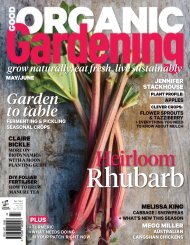1. Good Organic Gardening - January-February 2016
1. Good Organic Gardening - January-February 2016
1. Good Organic Gardening - January-February 2016
You also want an ePaper? Increase the reach of your titles
YUMPU automatically turns print PDFs into web optimized ePapers that Google loves.
Sandra & Mick Nanka | GARDENING FOLK<br />
Prevention is better than cure is<br />
their philosophy, so they find growing a<br />
multitude of herbs around the vegetables<br />
and not planting them in blocks works<br />
really well to cause confusion for the<br />
would-be attackers.<br />
Calendulas galore: a plant with so many uses<br />
potentially harmful chemicals in them,<br />
says Sandra.<br />
“Nature finds a balance, and a few<br />
holes here and there in the leaves don’t<br />
really matter. That’s why we even limit<br />
our organic pest control methods —<br />
because we don’t want to harm any of the<br />
beneficial insects. It’s important to nourish<br />
the soil, and using organic methods will<br />
equate to healthy soil, leading to healthy<br />
plants, healthy humans and a healthy<br />
planet. Simple!”<br />
The fertilisers used include manure from<br />
their chooks, worm castings from their<br />
The Nankas’ top<br />
gardening tips<br />
Grow your own herbs and produce in<br />
mixed profusion to confuse insects.<br />
Plant crops in the right season.<br />
Use herbs in the compost heap to add<br />
minerals and help with breakdown.<br />
When planting new plants:<br />
– Soak seedlings in a seaweed solution<br />
before planting.<br />
– Add compost at the time of planting.<br />
– Always fill the planting holes with<br />
water first to ensure the soil is moist.<br />
Let the annual herbs go to seed to<br />
attract beneficial insects.<br />
“The feature vegetable<br />
garden is in the<br />
mandala style with<br />
bamboo used for edging.<br />
There are also tank beds<br />
and an area that’s a mix<br />
of vegies grown in rows<br />
with fruit trees dotted<br />
in between.<br />
two bathtub worm farms and compost and<br />
pelletised manure during the growing season.<br />
Compost production at Mudbrick<br />
Cottage comprises five heaps <strong>1.</strong>5m by <strong>1.</strong>5m<br />
each. In the main garden there’s a large<br />
black compost bin and, in the nursery,<br />
two further large heaps for all the plants<br />
classed as throw-outs.<br />
When it comes to bugs, organic controls<br />
are the only methods Sandra and Mick use:<br />
homemade white oil and Eco-oil on the fruit<br />
trees and certified organic pyrethrum on<br />
the odd occasion. If there are any red spider<br />
mite outbreaks they order in some predatory<br />
mites to control them.<br />
The abundance of<br />
the Nankas’ garden<br />
“I love that we can look out across our garden<br />
and think how wonderful that something so<br />
beautiful (well, I think it’s beautiful) can also<br />
be so useful,” says Sandra.<br />
She and Mick think the most unique<br />
feature of their garden is the vast number of<br />
herb species they have growing and I’d have<br />
to agree.<br />
When asked what they like to do with their<br />
harvests, both agree they love cooking and<br />
herbs are an integral part of every meal. Even<br />
the Mudbrick Cottage chickens have herbs<br />
mixed into their daily diet.<br />
Salads are at the top of the list in the<br />
meals department — Sandra says they<br />
often have up to 40 different plants in each<br />
salad. Then there are herbal teas, infused<br />
oils, ointments, tinctures, syrups and<br />
poultices made lovingly on a regular basis<br />
in the Nankas’ home.<br />
The dehydrator also gets a workout<br />
drying excess herbs and vegetables<br />
while pestos, herb butters, chutneys and<br />
jams are other ways they prolong their<br />
enjoyment of their harvest.<br />
You can find the Nankas’ online herb<br />
business at herbcottage.com.au<br />
Facebook: Mudbrick Cottage Herb Farm<br />
Salvia officinalis: both leaves and flowers are edible<br />
on the sage plant<br />
<strong>Good</strong> <strong>Organic</strong> <strong>Gardening</strong> | 37
















